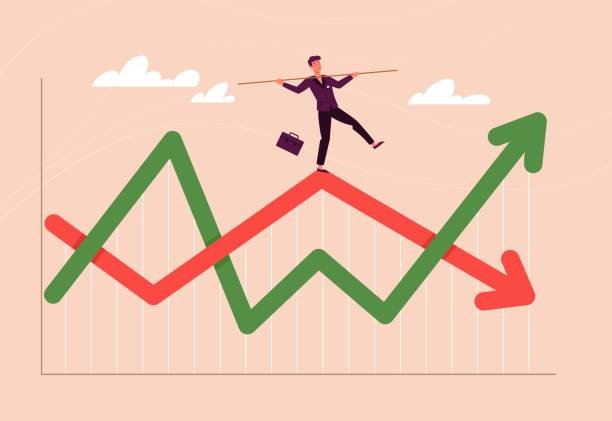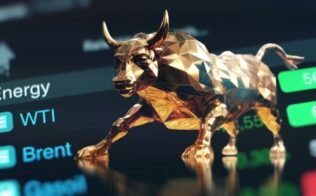What Is Volatility?
Volatility is the measure of statistical analysis of the returns of the dispersion for a given stock or index of the market. In the majority of circumstances, the more heightened the volatility, the more dangerous the security will be. Volatility is usually measured from the variance or standard deviation between the returns of the same security or index of the market.

Volatility in the share market is the pace at which the stock price in the market falls or rises over a period of time. The higher price of the stock volatility generally indicates a higher risk of the stock and helps investors estimate possible movements of the stock in the future.
In the stock market, volatility usually involves sharp swings in both directions. Let’s say when the stocks in the market rise and fall by more than 1 percent over an extended period of time, it is called an “unstable” market. The volatility of an asset is an essential factor when options of the pricing contracts.
Market volatility is no different from the volatility in the share market as there is not much difference between these markets. Also, volatility is the frequency and intensity of price movements, that is, up or down movements in the market. The larger and more frequent the movements of the price are, the more volatile the market becomes and is.
Read: How to Predict the Stock Market – Complete Guide
Simply, volatility represents how exactly prices of large swings around the stock mean price. We can say that volatility is a statistical calculation of dispersion returns. There are multiple distinct ways to estimate volatility, which include coefficients beta, pricing models option, and returns of standard deviations.
Assets in the market that are volatile are often considered riskier than the assets in the market that are less volatile. The reason behind this is the asset’s price is anticipated to be low. Volatility is considered a very crucial variable for calculating the prices of the option.
In volatility, a standard deviation with high volatility is the indication or the suggestion that the prices are spread across a spectrum that is typically wide. Contrarily, a standard deviation that has low value is the indication or the suggestion that the stock or asset prices are knit closely across a range that is narrow.
However, volatility is not a concept of singularity or measurement. Rather it is multifaceted.
Conception Of Volatility
Volatility is generally referred to as the degree of uncertainty or risk associated with the degree to which a value of securities will change. A higher volatility means a security’s value will likely span a wider range of values.
This tells that the security’s price can transform exponentially in a very brief period. It can be changed in any direction. Lower volatility tells or points out that the value of the security doesn’t swing as much and manages to be better stable.
One way to measure the change in an asset is to quantify the daily return or percent change on a regular basis of the asset. The volatility of an asset’s returns is represented by historical volatility, which is based on historical prices. This number is defined to be unitless, and it is described in percentage (%).
How To Compute Volatility In The Market?
Volatility is usually calculated by using the variance and the standard deviation; the standard deviation is defined by the variance square root. Since volatility is an expert in describing changes in the market over a particular period, all you need to do is take the standard deviation for calculation and then multiply this standard deviation with the square root of the number of time periods.
The formula for calculating volatility can define as follows:
Vol= sigma multiplied by the square root of (T)
Where: ‘V’ is volatility over some period of time.
Sigma represents the standard deviation of stocks or shares returns in the market.
‘T’ represents the number of periods in the horizon of the time.
For the sake of simplicity, let’s say a trader or an investor has a monthly closing stock price worth one dollar to ten dollars. For example, the first month is dollar one; the second month is two dollars, the third month is three dollars, and so on.

For calculating variance, you have to follow the five steps that are mentioned below:
1. The first thing you have to do is to find the mean value of the data set. In this, you have to add the values and then divide them by the number of values. If we add dollar one, plus dollar two, plus dollar three, all the way to up to dollar ten, then we get dollar fifty-five.
This number is then again divided by ten. The reason for again dividing the final value by ten is that we have a total of ten numbers in our data set. This furnishes a mean or average price of dollar five point fifty-five.
2. In the second step, you have to calculate the difference between every data value and the total mean. This is often referred to as bias. Let’s take an example; let’s say we take dollar ten and dollar five point fifty and subtract them. The value you will get after subtracting them is dollar four, then subtract dollar nine and dollar five point fifty, which is equal to dollar three point fifty.
This will continue until the value of the first data, which is dollar one. In this, Negative numbers or values are allowed. Since we need every value, these calculations are recommended and are usually done in a spreadsheet.
3. In the third step, you require the square of the deviations. This will help you eliminate the negative values that you have got.
4. In the fourth step, you have to add the deviations that are squared together. In the example mentioned, that equals 82.5.
5. In the fifth step, you have to divide the squared deviations sum by the numbers values of data you have which is here in the example is 82.5.
Also Read: What is SEBI: Role, Structure, and Powers
In this situation, the resulting difference is eight point twenty-five dollars. You have to take the standard deviation square root. This equates to two point eighty-seven dollars. This gives traders an idea of the deviation between the price and the average.
If prices in the market were sampled randomly from a normal distribution. About sixty-eight percent of all data values would fall within 1 standard deviation.
95 percent of data values will fall within 2 standard deviations, which in our example is two multiplied by 2.87, and 99.7 percent of all values will fall within 3 standard deviations, which is three multiplied by 2.87. In this case, the values from dollar one to dollar ten are not distributed randomly on the bell curve. Instead of distributing randomly, they are evenly distributed.
On that account, the expected percentage of sixty-eight percent to ninety-five percent or ninety nice points seven percent is incorrect. Despite this limitation, traders in the market frequently use standard deviation. Because the payback data sets prices are often more similar to a normal distribution or bell curve than the example given here.
Different Types Of Volatility
Various types of volatility are found in the stock market. These different types of volatility in the market are mentioned and briefly discussed in the below points.
1. Implied Volatility:
Implied volatility is considered a feature of the market in options trading. Implied volatility, or IV, also called expected volatility, is one of the most crucial metrics for the traders involved in options trading. As its name suggests, this allows these traders to determine how the state of market volatility will be in the future.
This concept of volatility also allows traders to calculate the probabilities. A crucial point to note here is that it should not be considered science. So it does not make a forecast of future market developments.
Unlike other volatility like historical volatility, implied volatility comes to the traders from the price itself from the options and represents the expectation of volatility in future markets.
Because this is implied, traders in the market cannot use the performance of the past as an indicator of the performance in the future. Instead, they should estimate the potential of the market of the option.
2. Historical Volatility:
Historical volatility is also referred to as statistical volatility. Historical volatility or statistical volatility gauges the underlying fluctuations of the securities or the stocks in the market for measuring price that changes over a pre-determined amount of time. Historical volatility is the metric that is less prevalent as compared to implied volatility.
When the historical volatility rises, a security’s or stock’s price will also be moving more than its normal time. At this juncture, there will even be an expectation that something may, will, or has changed. If the dropping of the historical volatility takes place, on the opposite, it points to any eliminated uncertainty, so things get back to the way they have to be.
This calculation of historical volatility may or can be based on changes of intraday, but these measure movements are often based on the change from one price closing to the next. This depends on the duration of the intended trading of the options; historical volatility or statistical volatility can be measured in increments that can range from ten to one hundred and eighty trading days.

Pricing Of Options And Volatility
Volatility is a crucial variable in pricing models of options, which estimates the extent to which the return from the underlying asset will fluctuate between now and the expiration of the options.
Volatility is expressed as a coefficient percentage within the formulas for option pricing that arises from the daily activities of the trading. The way of measuring the volatility will affect the coefficient value used.
Volatility is also used for options contracts price using models like a binomial tree or Black-Scholes models. More volatile assets underlying will be translated to the higher premiums options because, with the side of volatility, there is a greater or higher probability that the options will end up in the money at their expiration.
Traders in options trading try to predict the future volatility of an asset so that the option’s price in the market always tends to reflect its implied volatility.
Types Of Different Measures Of Volatility In The Market
Apart from the variance and standard deviation, volatility in the market can be measured or calculated in other different terms as well. These common terms can calculate these two different measures of volatility in the market.
These terms are mentioned and briefly discussed below in points:
1. Beta:
Beta shows the relativity between the relevant market index and the value of stocks in the market. This is the reason that the beta is considered a concrete stock volatility representation.
Beta tends to represent the approximate volatility in the market in returns of the securities or the stocks in the market, which is off to its relevant index of the benchmark.
For example, if a particular stock has a beta value of one point two and its associated benchmark is Nifty fifty, this means that for a hundred percent change in the Nifty fifty index, that stock will change one twenty percent change in value. Contrarily, a beta value of zero point eight shows that if the Nifty fifty index changes by a hundred percent, the price of the stock will change by eighty percent.
A higher value beta in the market implies a higher index correlation and, therefore, high volatility, i.e., market dependence.
Must Read: Understanding Bear Market: Types, Causes, and Consequences
2. Index Volatility Or Volatility Index:
It depends on investors’ forecasts for the movement of particular securities, stocks, or the broader market. The volatile index was designed by the CBOE or Chicago Board Options Exchange. VIX, or the volatile index takes into account the opinions of investors; therefore, a high VIX or volatile index indicates a risky and unstable market and vice versa.
Factors That Are Affecting Volatility
Numerous different factors affect the volatility of the stock market as well as its securities or stock counterpart. These are mentioned below in points:
1. Securities or stock supply and demand in the stock market.
2. Geopolitical factors that are prevalent in an economy.
3. Factors of socioeconomic.
4. Date of expiration of contracts of the options in the stock market.
However, a market that is volatile does not always mean loss but risk. And investors who are seasoned can capitalize on the volatility of the market in their favor by using their options contracts promptly for substantial profits or to protect their portfolios against possible declines.

What Does It Mean By Volatility Smile In The Stock Market?
The volatility smile in the stock market is the shape of a graphic that comes from charting the implied volatility and price of the strike of a set of contracts. These contracts will all have the same asset underlying and the same date of expiration.
When an underlying asset moves from “out of money” to “in the money” or vice versa, its implied volatility will first decrease. It then bottomed out at the parity point and then rallied.
Due to this process, the shape resembles a smile. A contract of the options with the lowest volatility implied in the market when traded in money; means that the market value and the strike price of the underlying asset are similar.
What Does It Mean By Volatility Skew In The Stock Market?
Volatility skew, as its name suggests, is more about skewed balance than smile volatility. It shows the different IVs between an option of “in the money”, the option of “out of the money”, and an option of “at the money”.
A chart trend occurs when one process is assigned a higher level of implied volatility than another process.
Examples Of Volatility
Let’s say, for example, that an investor in the stock market builds a portfolio for their retirement. Since they will be retiring in the next few years, they are looking for stocks or securities with volatility that will be low and gives steady returns. That trader looks at two companies:
1. ABC Corporation stocks in the market has a coefficient of the beta of zero point seventy-eight. This makes the stock of ABC Corporation in the stock market slightly less volatile as compared to the S&P five hundred index.
2. XYZ Corporation stocks in the market have a coefficient of beta in the market of one point forty five which makes this stock of XYZ Corporation significantly more volatile than the S&P five hundred index.
A more conservative investor may choose the first corporation stock in the market for their portfolio because it is less volatile and it has a value for the short term that is more predictable.

Investors can feel uncomfortable during periods of high volatility as the prices during this period can fluctuate wildly or drop suddenly.
Professionals advise long-term investors to ignore periods of volatility for the short term and keep watching it. Indeed, in the long run, the stock market tends to rise. Meantime, emotions like greed and fear, which can amplify in the volatile markets, can undermine the trader’s strategy in the long term.
Some investors tend to use volatility as their opportunity to add to their portfolio by purchasing when the prices of the stocks in the market are relatively low.
Traders can also use strategies of hedging to manage volatility, such as purchasing the protective Put options in the market to limit losses without the need to sell the stock. But trader must note that there is a chance that the Put options can also become more expensive when volatility in the market for these stocks are higher.
Interesting Read: Understanding Demat Market: Features, Benefits, and Types of Demat Accounts
FAQs
Volatility is a benchmark in the statistical way of the data dispersion around its value of the mean over a given time. Volatility is calculated by the standard deviation multiplied by the square root of the total time period number, which is T. In finance, it is represented by the dispersion of prices of the stocks in the stock or the share market on a yearly basis.
Can We Conclude Volatility As A Risk In The Stock Market?
Volatility in the share market is often used for describing the risk, but it has not always been the risk case. Risk refers to the possibility of a loss, while volatility describes the extent and speed of price movement. If these bullish movements of the price in the stock market increase the risk of loss, so does the risk.
Is A Volatility In The Market A Good Thing For Traders Or Investors?
Volatility is good or bad, depending on the type of trader you are and your capacity to take risks. For investors who have long-term goals, volatility can be troublesome. Still, for day traders or intraday traders and the traders involved in options trading, volatility often creates opportunities for trading in the market.
Old Articles: Top 14 Stock Market Books 2023- Must Read
One response to “Understanding Volatility: What Is Volatility in the Stock Market?”
Leave a Reply
Recent blog
Course
- Unlocking the Mysteries of Bull Markets: A Comprehensive Guide
- Understanding Blue Chip Stocks: Definition, Examples, and Investment Strategies
- What is SEBI: Role, Structure, and Powers
- Understanding Bear Market: Types, Causes, and Consequences
- Understanding Demat Market: Features, Benefits, and Types of Demat Accounts






[…] Read: Understanding Volatility: What Is Volatility in the Stock Market? […]